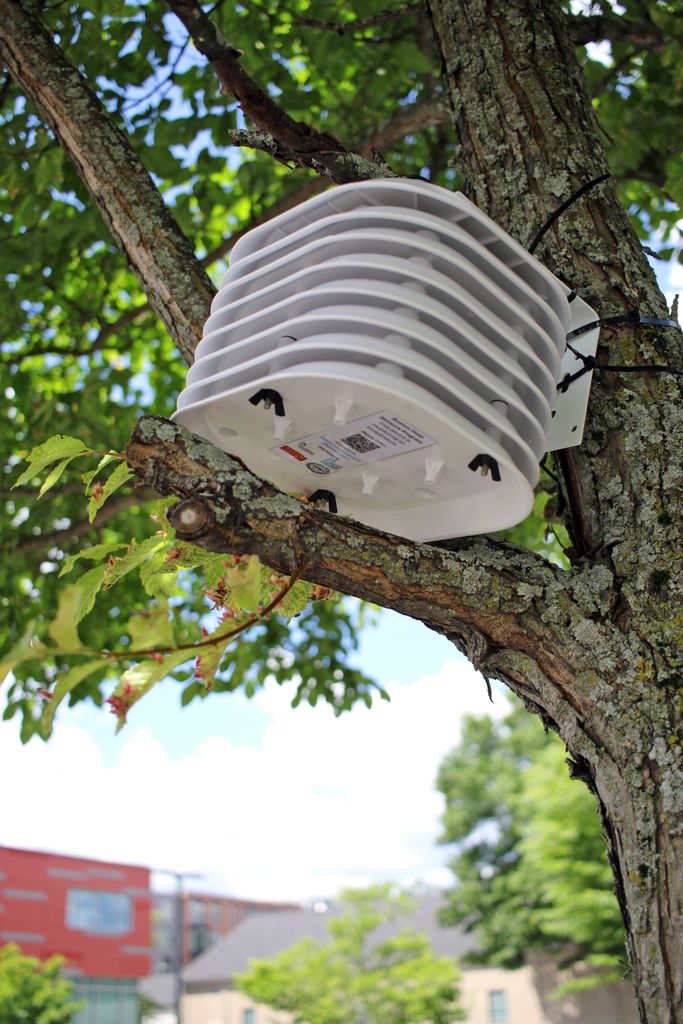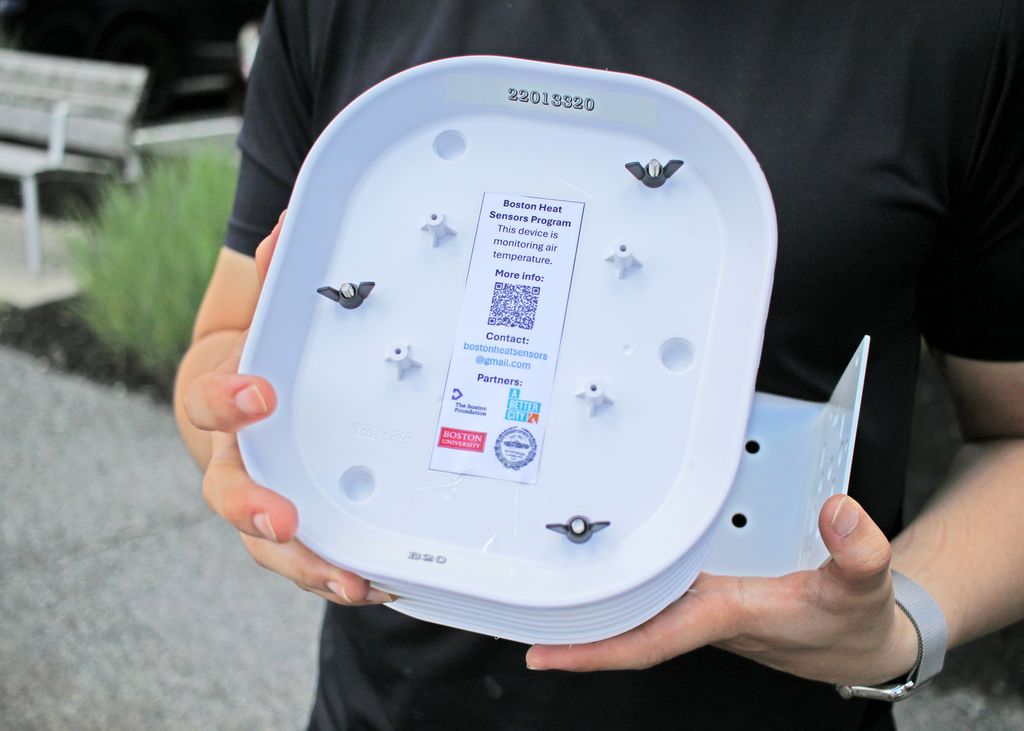Heatwave Watch.

Jonathan Lee (right center), a PhD student, and Ameera Saba (right), a BU undergraduate, install a sensor in a tree while Isabella Gambill (left), the project lead from A Better City, and Adam Lauziere-Vecanski (left center), facilities manager at Charles River Community Health, one of the host sites for the pilot project, observe. Photo: Megan Jones
Heatwave Watch
Researchers at SPH, partnering with the City of Boston and local nonprofits A Better City and The Boston Foundation, are piloting a more equitable method of declaring heat emergencies. This summer, Patricia Fabian, associate professor of environmental health, and her team will monitor sensors placed in vulnerable neighborhoods throughout the city.
Jonathan Lee reaches down from his position a few rungs up a ladder to accept a zip tie from Ameera Saba’s outstretched hand. Using his other hand, he balances a white box about the size of a small toaster against the crook of a tree branch. He secures the box to the tree with a few zip ties and then steps down to ensure that it is just out of reach of the ground, but the QR code printed on its bottom is still readable to passersby.
Over the past few weeks, Lee, an environmental health PhD student in Boston University’s Urban Biogeoscience and Environmental Health (URBAN) program, and Saba, a biomedical engineering undergraduate at BU, have crisscrossed the city deploying these white boxes in various Boston neighborhoods. The installation effort is part of a year-long initiative by the School of Public Health, in collaboration with City of Boston’s Environment Department and local nonprofits A Better City (ABC) and The Boston Foundation (TBF), to pilot a more equitable mechanism of declaring heat emergencies. The white boxes block solar radiation from the sensitive temperature and humidity sensors inside designed to capture information on how these neighborhoods experience heat.

“Heat is increasing in intensity and frequency across the globe due to climate change, and every day more connections are made between extreme heat and adverse health, including mental health,” says Patricia Fabian, associate professor of environmental health at SPH, associate director of the BU Institute for Global Sustainability, and one of the pilot project leads. “Extreme heat impacts everyone, but particularly vulnerable groups like babies, pregnant people, older adults, and people on certain medications. Having accurate information about temperatures in local heat islands will help cities prepare for extreme heat events and protect those most vulnerable.”
The heat island effect explains why some parts of the city heat up more than others when summer temperatures soar. While parks and other areas with green space and greater tree cover provide shade, and cool the air through evaporation and transpiration, the dark roofs and asphalt of densely developed areas absorb and radiate the sun’s heat. For example, through another research project called C-HEAT, Fabian and her colleagues have recorded up to a 7-degree difference between hotter and cooler city blocks in Chelsea and East Boston.
The idea for this summer’s temperature pilot took shape during a recent Boston Green Ribbon Commission meeting hosted by TBF that Fabian attended alongside Isabella Gambill, assistant director of climate, energy, and resilience at ABC, and Zoe Davis, climate resilience project manager on the Climate Ready Boston Team in the City of Boston’s Environment Department. Following the meeting, where Fabian presented of work from the C-HEAT study, she discussed with Gambill and Davis the value of monitoring temperatures in specific Boston neighborhoods, particularly those identified as the hottest in the City’s Heat Resilience Plan: Chinatown, Dorchester, East Boston, Mattapan, and Roxbury. The pair endorsed the idea, prompting the group to approach another attendee, Julia Howard, senior program officer for climate at TBF, to collaborate on a proposal for funding.
The funding, which the group successfully secured through TBF, supports ABC to engage local businesses as sensor hosts and SPH students to assemble and deploy the sensors, as well as to collect and analyze the data. Davis then leveraged connections in Boston’s Parks and Recreation department to facilitate installation of the sensors in city trees. In just six weeks, the team transformed their vision into a funded initiative to enhance Boston’s heat monitoring capabilities.

“Lots of connections and previous work came together for this pilot to be organized in record time,” says Fabian, who has participated in an extreme heat working group convened by ABC and led by Gambill for the past four years. “Every stakeholder has aligned—but slightly different—goals, and we are working to meet everyone’s priorities, whether that is temperature data, [community] engagement, or decision support.”
Currently, the National Weather Service (NWS) station at Logan Airport determines the official temperature reading for Boston. To declare a heat emergency, the NWS sensors must register a heat index (air temperature and relative humidity) of 95 degrees Fahrenheit for at least two consecutive days with nighttime temperatures 75 degrees or higher. With the help of students like Lee and Saba, Fabian and Gambill will deploy and monitor a total of 15 sensors throughout the city, gathering and analyzing data on hot spots to lay the foundation for a more equitable mechanism of declaring future heat emergencies.
Lee, who installed similar sensors in Chelsea for C-HEAT, leveraged data on temperature, built infrastructure, and environmental justice to map potential sites for the pilot sensors. “[The NWS] temperature monitor is used by the City of Boston to issue heat emergencies, but we hypothesize that sometimes inner-city areas can get considerably hotter,” he says.

Fabian and the team will attempt to answer questions such as: What factors should ultimately be considered in selecting the locations for the sensors? How challenging are they to install? And what kinds of resources are needed to process and share the data? Ultimately, they aim to launch a semi-permanent sensor network with the City of Boston and make neighborhood temperature data publicly accessible online via a platform similar to the Boston Public Schools’ dashboard for monitoring indoor air quality in classrooms, a project Fabian has also been involved in developing.
The sensors could not only prove useful in protecting public health during future heat waves, says Fabian. “[They are] also an opportunity to engage residents—particularly residents of communities on the frontlines of climate change—in long-term climate resilience solutions such weatherization, assistance programs, and clean technology, such as heat pumps and solar panels.”
In October 2023, Fabian spoke about extreme heat and health at greater length on The Lancet Voice podcast. Listen to the episode (linked below) to learn more.
